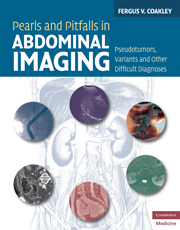Book contents
- Frontmatter
- Contents
- Preface
- Acknowledgements
- Section 1 Diaphragm and adjacent structures
- Section 2 Liver
- Section 3 Biliary system
- Section 4 Spleen
- Section 5 Pancreas
- Section 6 Adrenal glands
- Section 7 Kidneys
- Case 40 Radiation nephropathy
- Case 41 Lithium nephropathy
- Case 42 Pseudoenhancement of small renal cysts
- Case 43 Pseudotumor due to focal masslike parenchyma
- Case 44 Pseudotumor due to anisotropism
- Case 45 Echogenic renal cell carcinoma mimicking angiomyolipoma
- Case 46 Pseudohydronephrosis
- Case 47 Pseudocalculi due to excreted gadolinium
- Case 48 Subtle complete ureteral duplication
- Section 8 Retroperitoneum
- Section 9 Gastrointestinal tract
- Section 10 Peritoneal cavity
- Section 11 Ovaries
- Section 12 Uterus and vagina
- Section 13 Bladder
- Section 14 Pelvic soft tissues
- Section 15 Groin
- Section 16 Bone
- Index
- References
Case 41 - Lithium nephropathy
from Section 7 - Kidneys
Published online by Cambridge University Press: 05 November 2011
- Frontmatter
- Contents
- Preface
- Acknowledgements
- Section 1 Diaphragm and adjacent structures
- Section 2 Liver
- Section 3 Biliary system
- Section 4 Spleen
- Section 5 Pancreas
- Section 6 Adrenal glands
- Section 7 Kidneys
- Case 40 Radiation nephropathy
- Case 41 Lithium nephropathy
- Case 42 Pseudoenhancement of small renal cysts
- Case 43 Pseudotumor due to focal masslike parenchyma
- Case 44 Pseudotumor due to anisotropism
- Case 45 Echogenic renal cell carcinoma mimicking angiomyolipoma
- Case 46 Pseudohydronephrosis
- Case 47 Pseudocalculi due to excreted gadolinium
- Case 48 Subtle complete ureteral duplication
- Section 8 Retroperitoneum
- Section 9 Gastrointestinal tract
- Section 10 Peritoneal cavity
- Section 11 Ovaries
- Section 12 Uterus and vagina
- Section 13 Bladder
- Section 14 Pelvic soft tissues
- Section 15 Groin
- Section 16 Bone
- Index
- References
Summary
Imaging description
Long-term lithium therapy (primarily used for treatment of bipolar disorder) commonly results in impaired renal concentrating ability (leading to nephrogenic diabetes insipidus) and occasionally chronic kidney disease due to tubulointerstitial nephropathy. The latter constitutes lithium nephropathy, which is characterized clinically by decreased glomerular filtration rate and pathologically by chronic focal interstitial nephritis with tubular atrophy, parenchymal fibrosis, sclerotic glomeruli, tubular dilatation, and cyst formation [1–4]. The latter can be seen at imaging. The cysts of lithium nephropathy are typically small (1–2 mm), variable in number, and either randomly or primarily cortical in location (Figures 41.1–41.3) [5]. The kidneys may be normal in size or slightly atrophic.
Importance
The finding of abundant, uniform, and symmetrically distributed renal microcysts in normal-sized kidneys in a patient on long-term lithium therapy with renal insufficiency is strongly suggestive of lithium nephropathy and may eliminate the need for diagnostic confirmation by renal biopsy [5].
Typical clinical scenario
The multiple small scattered renal microcysts of lithium nephropathy are usually detected incidentally when a patient on lithium is imaged for unrelated reasons. The appearance is relatively characteristic, and should be correlated with lithium usage. In the largest published series to date, all of 16 patients on long-term lithium therapy with renal impairment demonstrated at least some renal microcysts at MRI [5]. In this series, the degree of renal impairment was variable (creatinine clearances of 20 to 70 mL/min) and all but three of the patients had clinical features of nephrogenic diabetes insipidus.
Information
- Type
- Chapter
- Information
- Pearls and Pitfalls in Abdominal ImagingPseudotumors, Variants and Other Difficult Diagnoses, pp. 138 - 141Publisher: Cambridge University PressPrint publication year: 2010
